NCSI treatment summary user guide Dec 2012 - National Cancer ...
NCSI treatment summary user guide Dec 2012 - National Cancer ...
NCSI treatment summary user guide Dec 2012 - National Cancer ...
You also want an ePaper? Increase the reach of your titles
YUMPU automatically turns print PDFs into web optimized ePapers that Google loves.
DisclaimerWe have made every effort to ensure that theinformation we have provided is accurate and will helpyou to introduce the Treatment Summary into the careand support that you provide. The <strong>National</strong> <strong>Cancer</strong>Survivorship Initiative (<strong>NCSI</strong>) cannot accept liabilityfor any inaccuracy in this information or that of thirdparties, such as on websites to which we link.ThanksThis <strong>guide</strong> has been written, revised and editedby the <strong>NCSI</strong> Treatment Summary steering group,which includes Macmillan <strong>Cancer</strong> Support GeneralPractitioner Advisers. We acknowledge and thankNHS Improvement, the <strong>National</strong> Leads and test sitesfor their work in developing and testing the TreatmentSummary and Tribal Consulting Limited for evaluatingthe work of the test sites.We also thank the Somerset <strong>Cancer</strong> Register andInfoFlex CIMS for their work in transforming thisconcept into an electronic solution.
Contents<strong>NCSI</strong> Treatment Summary – User <strong>guide</strong> and templates 2What is a Treatment Summary? 2When and how is it used? 2Why was it developed? 2Style and format 3TS templates and guidance 3Recommended practice for using the TS 3Summary of evaluation following testing 5Further information 5Appendix 1: Treatment Summary 6GP read codes for common cancers 7Appendix 2: Structured letter template 9Appendix 3: Treatment Summary example 10Appendix 4: Screenshot from Somerset <strong>Cancer</strong> Register 11Appendix 5: Rationale for data fields included in the Treatment Summary 12
<strong>NCSI</strong> Treatment SummaryUser <strong>guide</strong> and templatesWhat is a Treatment Summary?A Treatment Summary (TS) is a document producedby secondary cancer care professionals at the end ofinitial <strong>treatment</strong> for cancer and at other subsequenttrigger points. It is shared with the patient and theirGeneral Practitioner (GP). The TS describes the<strong>treatment</strong> that a person has received, its side effectsand signs and symptoms of recurrence. It will alsoinform the GP <strong>Cancer</strong> Care Review and enable theGP database to be kept up to date.It is aimed at:• GPs and primary care professionals• patients• secondary care clinicians, particularly in A&E andfor unplanned emergency admissions• hospices, day centres and care homes.When and how is it used?The TS is completed by the hospital clinician at theend of primary <strong>treatment</strong>, which may be followingsurgery and/or adjuvant therapy. It is then shared withthe patient and sent to the GP. The TS can replace orbe sent with the standard clinic letter on this occasion.It may also be used when there is a referral fromsecondary care to palliative care for symptom control.It may also be used at other points in the journey,for example following <strong>treatment</strong> for recurrence. TheTS will include details that are relevant to furthermanagement and care, for example endocrine or othermaintenance <strong>treatment</strong> and ongoing surveillance.Why was it developed?The TS was developed by the <strong>NCSI</strong> to improvecommunication between primary and secondary careprofessionals working with cancer patients. It will alsohelp GPs update their databases and better supportpatients and carers.Following a scoping exercise by the <strong>NCSI</strong> in2010, GPs reported that they were receiving lotsof information from secondary care but what wasmissing was a simple <strong>summary</strong> of the patient’s cancerdiagnosis, <strong>treatment</strong> and ongoing management plan.Clinic letters were often failing to give enoughinformation to allow patients to be fully managed inthe community. This resulted in unnecessary delaysand referrals back to secondary care.In 2009, a group of Macmillan GP advisers identifiedinformation that would be helpful at the end of initial<strong>treatment</strong>. The TS template was designed to capturethis information.The TS has been tested in secondary carecommunities across several tumour groups. In 2010,approximately 250 TSs were issued to GPs over sixmonths. The TS was evaluated via surveys, telephoneinterviews and face-to-face meetings with over 50clinicians. An updated version for wider use wasdeveloped based on this learning and subsequentlyused in test sites in 2011 and <strong>2012</strong>.It is for patients as well as health professionals. TheTS can help patients understand and get clarity abouttheir condition. They can share the information withothers, for example, for travel insurance purposes.2
<strong>NCSI</strong> Treatment Summary – User <strong>guide</strong> and templatesStyle and formatThere are three different formats for the TS. Cliniciansand administration staff can choose the template thatbest suits their local practice:• standard TS template• structured letter template• electronic solution.There are no copyright issues so any of the templatescan be adapted to suit local community or IT systems.Using the electronic solution template:The electronic template can be automaticallypopulated from the <strong>Cancer</strong> Information Systems (CIS)provided by Somerset <strong>Cancer</strong> Register and InfoFlexCIMS Ltd. It can then be added to the patient’selectronic record, making it quicker and easier fora clinician to complete at the end of <strong>treatment</strong>. Forfurther information, contact your CIS provider.TS templates and guidance• Appendix 1: the standard TS template withupdated GP READ codes• Appendix 2: the same information in a structuredletter template• Appendix 3: a completed example template withprompt notes• Appendix 4: an example screen shot from theSomerset <strong>Cancer</strong> Register• Appendix 5: a <strong>user</strong> <strong>guide</strong> with rationale for whydata has been included, showing which fields areessential and which are desirable (this informationis important if the form is going to be redesigned forlocal use).Different ways the templates were used during the TStesting process:• The majority used the template and boxes in theformats provided (Appendix 1).• Some used the structured letter template to makeit easier for secretarial staff to complete fromdictation (Appendix 2).• Some sent the TS electronically to the GP, whileothers printed and posted it.• One consultant used the TS instead of routine clinicletters at all appointments and gave the patient acopy when they left the clinic.Recommended practice for using the TS• All sections of the TS should be completed, withone copy given to the patient and another sent tothe GP. This should happen promptly at the end ofprimary <strong>treatment</strong> for cancer.• TS updates should also be generated at keypoints, eg following recurrence, further <strong>treatment</strong> ortransition to end of life care.• The TS should not replace a detailed care planbased on an assessment of need.• All members of the multidisciplinary team involvedin the patient’s care should have the opportunity tocontribute to the TS.• The GP will enter the details onto their databaseand use the information to inform the <strong>Cancer</strong> CareReview. See www.ncsi.org.uk/what-we-are-doing/assessment-care-planning/cancer-care-review/• The GP will make sure the patient is entered ontoappropriate monitoring, screening programmeand review surveillance systems if required, egosteoporosis.3
Health professionals who have tested the TS at the NHS Improvement test siteshave provided the following tips:• Involve administrative staff early on when changing to the TS system – and encourage them tosuggest the best way to implement it locally.• Make sure that all members of the medical records department are familiar with the TS and knowwhere it should be filed in a patient’s notes (this will avoid a TS being filed wrongly or removedfrom the patient’s records inappropriately).• If the TS template is redesigned to fit with hospital documents, check that data inclusions/fieldsaren’t removed as they are useful to others (see rationale for data fields, Appendix 5).• Provide a prompt list for clinicians to use as they dictate the information for the TS in clinic.• Create a template letter with headings to make it easier to fill in.• Always complete a TS at the end of initial <strong>treatment</strong> – add a reference in the clinic notes that thishas been done and file a copy in the case notes.• Provide GP READ codes attached to whichever TS format has been used or issue to GP practicesseparately.• Test the system with a few clinicians then review and amend the process if necessary before fullimplementation.• Attach the template or prompt list to the front of the case notes before the patient is seen in theclinic to encourage completion.• Pre-fill the entries where possible (electronically or by hand), such as for common signs andsymptoms of recurrence and <strong>treatment</strong> toxicities.• Consider creating a separate list of signs and symptoms and key contacts for complex tumourgroups.• If the TS template is set up on a local electronic database, add common side effects, signs andsymptoms of recurrence and medications as drop-down menus.• Use the TS available on InfoFlex CIMS or Somerset <strong>Cancer</strong> Register, where possible, as these willself-populate much of the detail.• Share testing and experiences with colleagues to encourage more people to use the TS.4
<strong>NCSI</strong> Treatment Summary – User <strong>guide</strong> and templatesSummary of evaluation following testingThe TS has been positively received in both primaryand secondary care. Eight out of ten GPs found ituseful or very useful. Over half felt it would make adifference to the way they managed patients andnine out of ten wanted to see its use continued. Themajority of hospital clinicians recognised the value ofsummarising what could be months of <strong>treatment</strong> andholistic care into a concise <strong>summary</strong>. One clinician feltthat ‘it made us document and communicate better’another thought it was ‘excellent to be able to accessall the relevant data quickly in a short document’.Further informationTS templates and <strong>NCSI</strong> reports are available on the<strong>National</strong> <strong>Cancer</strong> Survivorship Initiative website atwww.ncsi.org.uk/what-we-are-doing/assessmentcare-planning/<strong>treatment</strong>-<strong>summary</strong>/or contact: Dr Rosie Loftus, GP Macmillan Lead,rloftus@macmillan.org.ukor Noeline Young nyoung@macmillan.nhs.ukPatients found the TS useful because it kept all thenecessary information in one place.They were able to share the information with familyor carers, and use it if they were admitted in anemergency or to another hospital or hospice and whenapplying for travel insurance.5
Appendix 1: Treatment SummaryAll templates are available on ncsi.org.ukDear Dr Re: Your patient has now completed their initial <strong>treatment</strong> for cancer. Please find below a <strong>summary</strong> of their diagnosis,<strong>treatment</strong> and ongoing management plan. The patient has a copy of this <strong>summary</strong>.Diagnosis: Date of diagnosis: Organ/Staging:Local/Distant:Summary of <strong>treatment</strong> and relevant dates:Treatment aim:Possible <strong>treatment</strong> toxicities and/or late effects:Alert symptoms that require referral back to specialist team:Secondary care ongoing management plan: (tests, appointments etc)Advise entry onto primary care palliative orsupportive care register:Yes/NoDS 1500 application completed:Yes/NoPrescription charge exemption arranged:Yes/NoContacts for re-referrals or queries:In hours:Out of hours:Other service referrals made: (delete or add)District nurseAHPSocial workerDieticianClinical Nurse SpecialistPsychologistBenefits/Advice serviceOtherRequired GP actions in addition to GP <strong>Cancer</strong> Care Review: (eg ongoing medication, osteoporosis and cardiac screening)Summary of information given to the patient about their cancer and future progress:Additional information, including issues relating to lifestyle and support needs:Completing clinician: Signature: Date:6
<strong>NCSI</strong> Treatment Summary – User <strong>guide</strong> and templatesGP read codes for common cancers (For GP use only). Other codes available if required. (Note: System codes arecase sensitive so always ensure codes are transcribed exactly as below)(October 2010 release).System 1 (5 digit codes) All other systems Version 3 fivebyte codesDiagnosis:DiagnosisLung malignant tumour XaOKG Malignant neoplasm of bronchus or lung B22z.Carcinoma of prostate X78Y6 Malignant neoplasm of prostate B46..Malignant tumour of rectum XE1vW Malignant neoplasm of rectum B141.Bowel intestine X78gK Malignant neoplasm of colon B13..Large bowel X78gN Malignant neoplasm of female breast B34..Female malignant neoplasia B34.. Malignant neoplasm of male breast B35..Male malignant neoplasiaHistology/Staging/Grade:B35..Histology/Staging/Grade:Histology abnormal 4K14. Histology abnormal 4K14.Tumour grade X7A6m Tumour staging 4M…Dukes/Gleason tumour stage XaOLF Gleason grading of prostate cancer 4M0..Recurrent tumour XaOR3 Recurrence of tumour 4M6..Local tumour spreadX7818Mets from 1° XaFr. Metastatic NOS BB13.TreatmentTreatmentPalliative radiotherapy 5149. Radiotherapy tumour palliation 5149.Curative Radiotherapy XalpH Radiotherapy 7M371Chemotherapy x71bL Chemotherapy 8BAD.RadiotherapyTreatment aim:Xa851Treatment aim:Curative procedure Xallm Curative <strong>treatment</strong> 8BJ0.Palliative procedure XaiL3 Palliative <strong>treatment</strong> 8BJ1.Treatment toxicities/late effects:Treatment toxicities/late effects:Osteoporotic # Xa1TO At risk of osteoporosis 14O9.Osteoporosis XaELC Osteoporosis N330.InfectionOngoing Management PlanXa9uaOngoing Management PlanFollow up arranged (1yr)XaL..No FU 8HA1. No follow up arranged 8HA..Referral PRN8HAZ.7
System 1 (5 digit codes) All other systems Version 3 fivebyte codesReferrals made to other services:Referrals made to other services:District Nurse XaBsn Refer to District Nurse 8H72.Social Worker XaBsr Refer to Social Worker 8H75.Nurse SpecialistSALTActions required by the GPXaAgqXaBT6Actions required by the GPTumour marker monitoring Xalqg Tumour marker monitoring 8A9..PSA Xalqh PSA 43Z2.Osteoporosis monitoring XalSd Osteoporosis monitoring 66a..Referral for specialist opinionXalstAdvised to apply for free prescriptions 9D05 Entitled to free prescription 6616.<strong>Cancer</strong> Care Review Xalyc <strong>Cancer</strong> Care Review 8BAV.Palliative Care Review XalG1 Palliative Care Plan Review 8CM3.Medication:Medication:New medication started by specialist XEOhn Medication given 8BC2.Medication changed by specialist 8B316 Medication changed 8B316Advice to GP to start medicationAdvice to GP to stop medicationInformation to patient:XaKbFXaJC2Information to patient:DS1500 form claim XaCDx DS1500 completed 9EB5.Benefits counselling 6743. Benefits counselling 6743.<strong>Cancer</strong> information offered XalmL <strong>Cancer</strong> information offered 677H.<strong>Cancer</strong> diagnosis discussed XalpL <strong>Cancer</strong> diagnosis discussed 8CL0.Aware of diagnosisUnaware of prognosisCarer aware of diagnosisMiscellaneous:XaQlyXaVzEXaVzAMiscellaneous:On GSF palliative care framework XaJv2 On GSF Palliative Care Framework 8CM1.GP OOH service notified Xaltp GP OOH service notified 9e0..Carers details 9180. Carer details 9180.8
<strong>NCSI</strong> Treatment Summary – User <strong>guide</strong> and templatesAppendix 2: Structured letter templateAll templates are available on ncsi.org.ukDate: Dear Dr Re: Your patient has now completed their initial <strong>treatment</strong> for cancer. Please find below a <strong>summary</strong> of their diagnosis,<strong>treatment</strong> and ongoing management plan. The patient has a copy of this <strong>summary</strong>.Diagnosis:Date of diagnosis:Staging:Summary of <strong>treatment</strong> and relevant dates:Treatment aim:Possible <strong>treatment</strong> toxicities and/or late effects:Alert symptoms that require referral back to specialist team:Secondary care ongoing management plan: (tests, appointments)Required GP actions: (eg medication, osteoporosis/cardiac screening)Summary of information given to the patient and/or their carer:Additional information including issues related to lifestyle and support needs:Advise entry onto primary care palliative or supportive care register: (Yes/No)DS1500 application completed: (Yes/No/N/A)Prescription charge exemption arranged: (Yes/No)Contact for re-referral or any queries;Yours sincerelyIn hoursOut of hours:CC: 9
Appendix 3: Treatment Summary exampleAll templates are available on ncsi.org.ukDear Dr JonesRe: John Smith, 3 Park Road, Doncaster DN4 DEF DoB: 10.10.10 NHS No: 123456Your patient has now completed their initial <strong>treatment</strong> for cancer. Please find below a <strong>summary</strong> of their diagnosis,<strong>treatment</strong> and ongoing management plan. The patient has a copy of this <strong>summary</strong>.Diagnosis:Colorectal cancerDate of diagnosis:10.02.10Organ/Staging:Local/Distant:Dukes T2N0Summary of <strong>treatment</strong> and relevant dates:Surgery – Resection (March 10) and reversal of stoma (Sept 10)Radiotherapy – May–June 2010Possible <strong>treatment</strong> toxicities and/or late effects:Diarrhoea following pelvic radiotherapyAlert symptoms that require referral back to specialist team:• Diarrhoea for more than two weeks not relieved by loperamide/codeine• Blood or mucus per rectum• Further change in bowel function• Abdominal pain that persists for longer than four weeks and does notrespond to simple analgesiaSecondary care ongoing management plan: (tests, appointments etc)• Next OP Review – Jan 2011• CEA next due in Jan 2011 then annually until 2015• CT scan (abdo and chest) next due Sept 2011• Colonoscopy repeat next due Sept 2015Treatment aim:CurativeAdvise entry onto primary care palliative orsupportive care register:NoDS 1500 application completed:NoPrescription charge exemption arranged:YesContacts for re-referrals or queries:In hours: 01234 567890 (CNS team)Out of hours: 01234 987654 (oncology ward)Other service referrals made:Community dieticianBenefits/Advice serviceRequired GP actions in addition to GP <strong>Cancer</strong> Care Review: (eg ongoing medication, osteoporosis and cardiac screening)Please review dose of XXXXX in two months if symptoms of XXXX resolved reduce to 4mg dailySummary of information to the patient and/or their carer:Patient and wife informed that the cancer in his colon was non-invasive and that he has received surgery and radiotherapywith curative intent. He is aware however that it may recur in the future and we have briefly discussed the further <strong>treatment</strong>available should this be required. He is fully aware of the symptoms of recurrence and what to do should any occur.Additional information, including issues relating to lifestyle and support needs:Patient advised to quit smoking and referred to smoking cessation clinic.Patient keen to join local colorectal support group and plans to attend next session in November.Completing clinician: Charles Goodenough Signature: Date: 30.10.1010
<strong>NCSI</strong> Treatment Summary – User <strong>guide</strong> and templatesAppendix 4:ScreenshotfromSomerset<strong>Cancer</strong>RegisterPlease note: a fictional patienthas been used to demonstratethe system.11
Appendix 5: Rationale for data fields includedin the Treatment SummaryField Why include this? Essential (E) orDesirable (D)DiagnosisOrgan staging/local ordistant spread (grade)Date of diagnosisSummary of <strong>treatment</strong>and relevant datesTreatment aimPossible <strong>treatment</strong>toxicities and/or lateeffects of <strong>treatment</strong>Advise entry ontopalliative or supportivecare registerKey contact in hours foradvice and re-accessDS 1500 status (benefitthat a patient can claim atthe last six months of life)Prescription exemption12• Important for the GP and patient to know the type and location of cancerand the likely source of secondary recurrence.• Information about staging and spread provides insight into prognosis andrisk of recurrence.• Shows how long the patient has known their diagnosis.• Shows the time period between referral from primary care and diagnosis –helps identify where delays can be minimised in future.• Important data for monitoring <strong>treatment</strong> outcomes in relation tosurvivorship.• Helps plan the date of a GP <strong>Cancer</strong> Care Review.• To understand the range and order of <strong>treatment</strong>/s and the likely sequenceof <strong>treatment</strong> effects.• Essential to inform future <strong>treatment</strong> choice if further disease occurs.• Important information for patients wishing to take out insurance or amortgage.• Shows whether <strong>treatment</strong> intended is curative, palliative or for symptomrelief – helping the GP understand the aims of <strong>treatment</strong> and to refer backto secondary care or other services appropriately.• Supports the GP to anticipate future care needs.• Patients undergoing some cancer <strong>treatment</strong>s may be more prone totoxicity and late effects of <strong>treatment</strong> such as osteoporosis or heartdisease. Including risks here will help ensure the patient is entered ontoappropriate ongoing surveillance programmes by the GP practice (seeQuality Outcome Framework (QOF).• Signs and symptoms addressed earlier may improve quality of life and<strong>treatment</strong> outcomes from side effects or late consequences of <strong>treatment</strong>.• Suggested or preferred <strong>treatment</strong> associated with toxicities and lateeffects can be initiated without the patient needing to be referred back tothe specialist.• Raises awareness of common late effects and reduces delays to furtherinvestigation and <strong>treatment</strong>. This may also impact on survival rates assymptoms are picked up sooner.• Including the patient on the palliative care register ensures that the out ofhours (OOH) teams are made aware that a patient is nearing end of life,and they and their carers may need more support.• The register is shared with all relevant OOH doctors, as well as staff fromthe ambulance service, community district nursing teams, Macmillansupport team, social care and hospice, as appropriate. Patients can thenreceive the support, information and benefits they need.• To ensure the patient, GPs and primary care team know who and when tocontact should they have queries or concerns.The contact should be able to triage enquiries and initiate action.• If a DS 1500 hasn’t already been completed, this will prompt the GP toarrange this.• If a prescription exemption hasn’t been completed, this will prompt the GPto arrange one. All cancer patients are entitled to have their prescriptioncharges waived for any cancer <strong>treatment</strong> or drug they need.EDEEEEEEEE
<strong>NCSI</strong> Treatment Summary – User <strong>guide</strong> and templatesField Why include this? Essential (E) orDesirable (D)Alert symptoms thatrequire referral back tospecialist teamContact for re-referralsor queries in and out ofhoursSecondary care ongoingmanagement planReferrals to otherservicesRequired GP actionsincluding medication etc<strong>Cancer</strong> Care RegisterSummary of informationprovided to patient ondiagnosis and prognosisAdditional information tothe patient and/or theircarerREAD Codes Include acopy of the READ codeswith the TS. You maychose to send local GPpractices a laminatedcopy of the READCodes in advance tosave sending each time.• This should only include the symptoms where immediate re-referral to asecondary care specialist is required (eg acute breathlessness requiring apleural tap) not the expected side effects of <strong>treatment</strong> that can be managedby the GP or community team.• Patients will have a better understanding about symptoms that they should beconcerned about and that should prompt them to contact the specialist team.• Confirms contact details for the patient or GP for advice on care or <strong>treatment</strong>or to arrange an urgent review. The OOH contact could be a ward, the acuteoncology team or the relevant on call team.• Include any planned outpatient reviews and surveillance tests dates (orapproximate timescales) – this provides a framework for GPs. If indicatedhere, further tests can be scheduled before the outpatient visits.• The patient will be better informed about follow up plans and what to expect.• It is reassuring for patients and carers to see the planned care, surveillanceand support –then they know what to expect and when.• Helps avoid duplication of referral if the patient visits the GP betweenappointments and is unsure of who is involved in their care.• Particularly useful with social care referrals and when the patient is known toother agencies.• Can help to reinforce the importance of attending appointments with otheragencies.• Useful to also include details related to third sector support and centressuch as a Maggie’s <strong>Cancer</strong> Caring Centres, if available.• To provide clarity on what the GP should expect in terms of the patient’songoing care and how they can support them.• Provides prompts, eg to add the patient to routine screening programmes tohelp mitigate late effects of <strong>treatment</strong>.• The patient will be more empowered to approach the GP if they need furtheradvice and support.• A specific request can be given to the GP to ensure continuity of care andavoid ambiguity.• Provides the GP with guidance and advice on which drugs, if any, needstopping and when. Also whether any adjustment is needed between followup appointments or following discharge.• May avoid inappropriate prescriptions, overdose or misuse. Particularlyimportant if the GP is going to continue to prescribe long term, ie endocrinemanipulation.• Patients will also know what to expect from their GP.• This reminder helps ensure the patient is entered onto the register and thatthey are formally reviewed by the GP within six months of diagnosis. This isa requirement for the QOF for all general practices.• Sharing information on what has been discussed with the patient andtheir carer, and any written information provided, improves the quality andopenness of the discussion that the GP can have with the patient.• Confirms which lifestyle information and advice the patient has been givenor signposted to, including details of local support groups and psychosocialsupport, complementary therapies, returning to work advice etc.• It is the GP’s responsibility to assign the appropriate codes and enter themon their systems. GP READ codes are similar to hospital HRG codes and areused to identify diagnosis, tests and <strong>treatment</strong>s. Both are complex systemsand must be input manually.• Including the READ codes in the TS prompts and encourages GPs toaccurately code patients. This helps improve patient safety in terms ofsurveillance, disease tracking and audit.• Please note: Codes may differ depending on the GP IT system used.EEEDEDEDD13
For further information please seeMacmillan <strong>Cancer</strong> Support Macmillan.org.uk<strong>National</strong> <strong>Cancer</strong> Survivorship Initiative ncsi.org.ukNHS Improvement improvement.nhs.ukPrinted on recycled paper - please recycleMAC13894



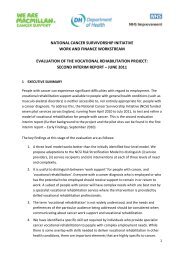

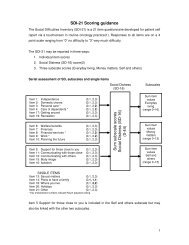
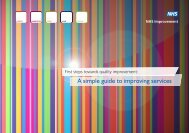
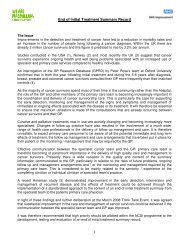
![Download the how to guide [PDF] - Macmillan Cancer Support](https://img.yumpu.com/47067428/1/184x260/download-the-how-to-guide-pdf-macmillan-cancer-support.jpg?quality=85)
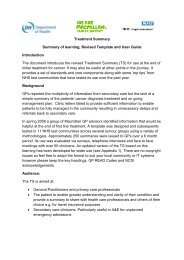

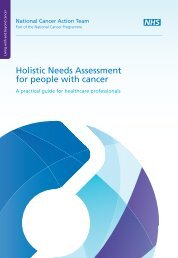
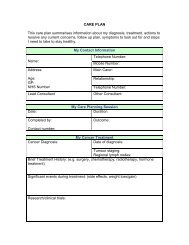

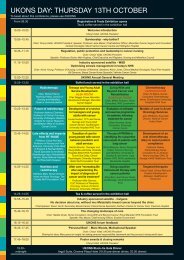
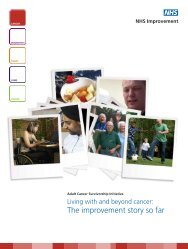
![HOPE Protocol [PDF, 420KB] - National Cancer Survivorship Initiative](https://img.yumpu.com/32566432/1/184x260/hope-protocol-pdf-420kb-national-cancer-survivorship-initiative.jpg?quality=85)